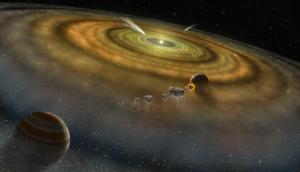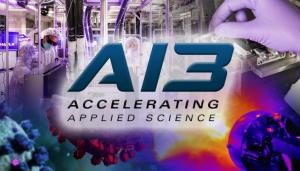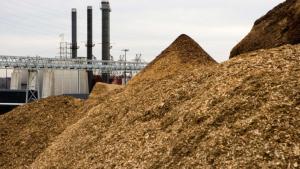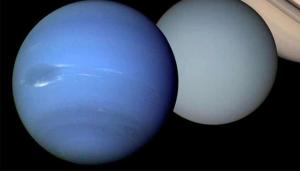LAB REPORT
Science and Technology Making Headlines
Jan. 7, 2022

An artist’s conception of the developing solar system, with the young sun at its center and (proto-) planets accreting dust and debris from the disk. Image courtesy of NASA.
Lost in space
By looking at the range of isotopic variations in terrestrial and meteoritic samples, a Lawrence Livermore scientist and collaborators have figured out that Earth and Mars formed by collisions of planetary embryos originating from the inner solar system.
Rocky planets may have formed by two fundamentally different processes, but it is unclear which one built the terrestrial planets of our solar system. The planets formed either by collisions among planetary embryos from the inner solar system or by accreting sunward-drifting millimeter-sized “pebbles” from the outer solar system.
In the new research, the team showed that the isotopic compositions of Earth and Mars predominantly result from the accretion of planetary bodies from the inner solar system, including material from the innermost disk unsampled by meteorites, with only a few percentages of a planet’s mass coming from outer solar system bodies.


LLNL’s AI Innovation Incubator (AI3) will serve as the foundation for a cohesive view of AI for Applied Science, built upon LLNL’s “cognitive simulation” approach that combines state-of-the-art AI technologies with leading-edge high performance computing.
Nurturing AI
Artificial intelligence (AI) and machine learning are emerging as important tools for addressing LLNL national security and science missions. The Lab has established the AI Innovation Incubator (AI3), a collaborative hub aimed at uniting experts in artificial intelligence (AI) from LLNL, industry and academia to advance AI for large-scale scientific and commercial applications.
LLNL has entered into a new memorandum of understanding with Google, IBM and NVIDIA, with plans to use the incubator to facilitate discussions and form future collaborations around hardware, software, tools and utilities to accelerate AI for applied science.
The goal of the AI Innovation Incubator (AI3) is to advance AI for applied science at scale.


A new company Is converting wood waste to hydrogen, which will help the country reach its climate goals.
Converting wood waste to hydrogen
Climatetech innovator Mote announced it is establishing its first facility to convert wood waste into hydrogen fuel while capturing, utilizing and sequestering carbon dioxide (CO2) emissions resulting from its process.
It’s estimated that more than 500 million metric tons of wood and agricultural waste are generated every year in the U.S., which today is either disposed of via natural decay, landfills or open-air burn, all of which return carbon to the atmosphere. With the engineering work of their first facility underway, Mote expects to produce approximately seven million kilograms of carbon-negative hydrogen and remove 150,000 metric tons of CO2 from the air annually. That’s equivalent to removing 32,622 cars off the road. Mote expects to start hydrogen production starting as soon as 2024.
“This is exactly the kind of project we need to meet our climate goals at a reasonable cost,” said Roger Aines, Chief Scientist of the Energy Program at LLNL. “Mote understands the energy system, and they are making a smart play for long-term impact.”


LLNL scientists have developed a new approach using machine learning to study with unprecedented resolution the phase behaviors of superionic water found in ice giants Uranus and Neptune
Come on in, the water is superionic
Scientists have created of a new phase of ice called "superionic ice." Turns out, the ice that tinkles in our glasses of Coke is just one of at least 19 different phases of ice.
Superionic ice was first predicted in 1988, and since then a number of research groups have used simulation and static compression techniques to try and study this phase of ice.
The first experimental evidence for superionic water ice came from a 2018 study by scientists from the Lawrence Livermore, UC Berkeley, and the University of Rochester. They first sandwiched a droplet of water between two diamonds that functioned like miniature anvils, squeezing the droplet with 2.5 GPa of pressure (25,000 atmospheres). This pre-compressed water into the room-temperature ice VII, a cubic crystalline form of ice.
The team then shifted to the University of Rochester's Laboratory for Laser Energetics where they bombarded one of the diamonds with up to six intense beams of UV light. This launched strong shock waves of several hundred GPa into the sample, to compress and heat the ice at the same time. The result verified the existence of superionic ice but was only able to create it for a few nanoseconds before it melted away - not long enough to measure its properties.
In a more recent study, conducted in 2019, the team was able to create a more stable form of the ice by squeezing a water droplet with a 0.2-carat diamond anvil and blasting it with a laser, pressurizing the droplet to 3.5 million times Earth's atmospheric pressure at temperatures hotter than the surface of the sun. The ice was the eighteenth form to be discovered, and so was named Ice XVIII ("Ice 18").


On Aug. 8, 2021, an experiment at the National Ignition Facility put researchers at the threshold of fusion ignition, achieving a yield of more than 1.3 megajoules — an 8X improvement over experiments conducted in spring 2021 and a 25X increase over NIF’s 2018 record yield. Image by John Jett/LLNL.
Top 10 LLNL Tweets of 2021
It’s a wrap for 2021. LLNL published the top 10 LLNL tweets of the year. Are you on Twitter? Follow LLNL at @Livermore_Lab.
Entries include scientist collecting data from the recent operational test of an Air Force Global Strike Command unarmed Minuteman III intercontinental ballistic missile; selection by NASA as a lead institution for the Pandora Project and other scientific breakthroughs all leading up to the No. 1 tweet: LLNL’s @lasers_llnl took a historic step forward in the decades-long quest for #fusion ignition on Aug. 8, achieving a yield of more than 1.3 megajoules. The milestone puts researchers at the threshold of #ignition & opens the door to new NIF experiments.





